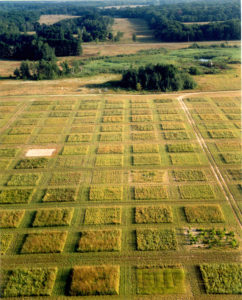
A large group of researchers, led by former Cedar Creek LTER Postdoc Yann Hautier (now at the University of Utrecht), tackled that question using data from the collaborative NutNet experiment and found that landscapes that support a diverse range of different plant communities (high 𝛽 diversity) also maintain many different ecological functions in those communities. Moreover, the team found that the positive effects of species (𝛼) and community (𝛽) diversity reinforced each other.
By analyzing data from the pretreatment plots of 65 NutNet sites (including six LTERs), the research team gained a truly global picture of grassland biodiversity at both the plot and landscape scale. The large multi-site experiment allowed them to resolve questions that would not have been possible with fewer sites.
The functions that researchers examined in this study included above-ground biomass; light capture; litter decomposition; and soil carbon, nitrogen, phosphorus, and potassium — all key supporting services for growing food and fiber. They used several different methods of calculating multifunctionality. While the exact shape of the relationships varied under different approaches, the overall conclusions were unchanged.
Recent awareness about landscape homogenization — that is, the tendency of landscapes in different places to look more and more similar — makes the research especially relevant. If both species and community diversity are needed to maintain the full range of ecosystem functions, then homogenization may involve greater risk than has previously been assumed.










